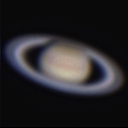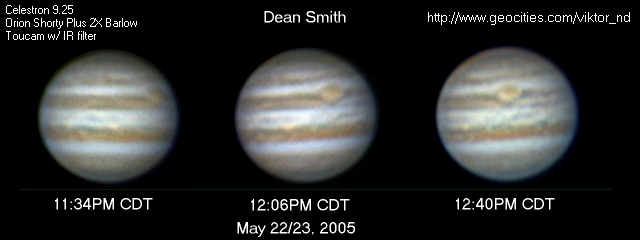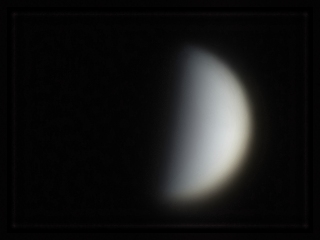Dean's Astro Images
 I own telescope a 6 inch dobsonian and a Celestron 9.25" SCT on the GOTO CG-5 mount. For imaging, I use either a Logitech Quickcam 4000 webcam or a Philips TOUcam that I point through whatever telescope I can get my hands on. I found the Quickcam and TOUcam to be very similar in image quality. The Quickcam is able to show Jupiter's moons without overexposing Jupiter. I also use an Olympus C-5000 digital camera for sky shots or pointing through the eyepiece. These are mostly under the aurora, Moon, and Sun sections.
I own telescope a 6 inch dobsonian and a Celestron 9.25" SCT on the GOTO CG-5 mount. For imaging, I use either a Logitech Quickcam 4000 webcam or a Philips TOUcam that I point through whatever telescope I can get my hands on. I found the Quickcam and TOUcam to be very similar in image quality. The Quickcam is able to show Jupiter's moons without overexposing Jupiter. I also use an Olympus C-5000 digital camera for sky shots or pointing through the eyepiece. These are mostly under the aurora, Moon, and Sun sections.
Many of these images were taken using the Planetary Science Observatory (an 18" NGT from JMI) owned by the Space Studies Department at the University of North Dakota.
You should also check out the Northern Sky Astronomical Society for deep sky CCD images from the same telescope.
Click here for Wratten filter data(You know you want to)
If you're as odd as me, you're curious about the transmission characteristics of your Wratten filters used for planetary contrast. This curiosity drove me to put together a page about the filters most common in astronomy. The data was gleaned from an old version of the CRC Handbook of Chemistry and Physics. Data for more filters can be found at
http://www.mat.uc.pt/~rps/photos/other-filters.html
|
Comets
Comet Holmes

I took several images of Comet Holmes in Oct/Nov 2007 and measured the diameter of its visible dust cloud in each one. This allowed me to find its expansion rate. Click the above image to see my other pictures in my Picasa web album.
Schwassman Wachman 3
April 17, 2006
I borrowed an ST-237 from an astronomy club member and put it on my C9.25 to image comet Schwassman Wachman 3. The field is only 6' wide. I imaged from my light-polluted back yard. The 'C' fragment is much brighter than the 'B' fragment which was barely visible in the eyepiece. The images are binned 2x2.
 | 
|
30s exposure
fragement 'B' | 40s exposure
fragment 'C'
|
May 7, 2006
Here is the 'C' fragment the morning of May 7, 2006 using a .63 focal reducer. The image is a combination of four 20 second exposures and is binned 2x2.

May 12, 2006
If I can add 4 images, why not 20? Using the same setup, I took 20 15-second exposures of the 'B' fragment and 20 10-second exposures of the 'C' fragment. The 'B' fragment is now brighter than 'C'. The comet was moving so fast that longer exposures caused the comet to trail. The images are full size but cropped. The gaps in the star trails are due to bad images that were not included.
 |  |
| fragement 'B' | fragment 'C' |
Aurora
Nov 7, 2004
Easily visible from town, I drove north of town to get a better view and get some pics with my new toy: an Olympus C-5000 digital camera. All images are 16s exposures at 160ASA.
out of town:
looking north
looking east
overhead
overhead
me!
backyard in town
looking south
looking SE
overhead (with power line)
Nov 8, 2004
As the astronomy club was setting up for a star party for South Middle School, we saw some brief northern lights activity over some heavy light pollution. I put my camera on my Tasco tripod and took these shots from the hood of my car.
image 1
image 2
March 6, 2005
Some low aurorae coming home from a Messier Marathon
March aurora
Albireo
My first non-solar system image through my 6" Dobsonian. This was also
the first image with my Logitech Quickcam 4000 Pro.

The Sun
May 17 and 18 of 2001
My first Sun images taken with a cheap Argus DC1500 digital camera through an 8" SCT
Image 1 -- Image 2
There are better Sun pictures on my Sun page
Saturn
August 31, 2003
After shooting Mars, I caught Saturn as it was rising. Like my Mars images, I used my logitech quickcam and a 2X barlow.

September 14, 2003
I removed the 2X Barlow to get a wider field of view hoping to get Titan. After some processing, I found that I not only got Titan but Dione, Rhea, and Tethys too! I was surprised to get 10th magnitude moons in 1/10th second exposures. The left image shows Titan and a hint of the other moons. The right image washes out Saturn but shows the dimmer moons.
Later, I put the Barlow back on and took another video. The seeing wasn't very good so I resized it 50%.

March 30, 2004
My first shot of Saturn high in the sky.

April 1, 2004
Another nice shot of Saturn.

2006
April 22, 2006
Two years later, I finally got a chance to image Saturn again. After a lot of dissapointments, I got a nice shot with my Celestron 9.25 and Toucam.

Jupiter
March 25, 2004
The weather finally got warm enough for me to take my laptop and webcam out again and I took my first images of Jupiter!

March 30, 2004
With five planets visible, my webcam was rather busy. This image of Jupiter and Io turned out very nice.

April 6, 2004
Two moon shadows and the Great Red Spot! Io's shadow is on the right and Europa's on the left. Click the image below to see an animated gif. These images were taken with the Physics Dept's 12"LX200 and my Logitech Quickcam.

April 13, 2005
Tried afocal imaging using my digital camera through my 6" Dob. The Moon works well this way but the planets have been more difficult. This is a processed stack of 5 images.

May 15, 2005
My first webcam image with my new Celestron9.25" SCT! Also my first decent Toucam picture.

May 22, 2005

May 20,2006
First shot of Jupiter in 2006. Same setup as last year. Jupiter is lower in the sky than last year.

Venus
March 30, 2004
half phase

May 14, 2004
Crescent phase

June 8, 2005
Rare new phase during solar transit! Venus was less than 4 degrees over my horizon.



 I own telescope a 6 inch dobsonian and a Celestron 9.25" SCT on the GOTO CG-5 mount. For imaging, I use either a Logitech Quickcam 4000 webcam or a Philips TOUcam that I point through whatever telescope I can get my hands on. I found the Quickcam and TOUcam to be very similar in image quality. The Quickcam is able to show Jupiter's moons without overexposing Jupiter. I also use an Olympus C-5000 digital camera for sky shots or pointing through the eyepiece. These are mostly under the aurora, Moon, and Sun sections.
I own telescope a 6 inch dobsonian and a Celestron 9.25" SCT on the GOTO CG-5 mount. For imaging, I use either a Logitech Quickcam 4000 webcam or a Philips TOUcam that I point through whatever telescope I can get my hands on. I found the Quickcam and TOUcam to be very similar in image quality. The Quickcam is able to show Jupiter's moons without overexposing Jupiter. I also use an Olympus C-5000 digital camera for sky shots or pointing through the eyepiece. These are mostly under the aurora, Moon, and Sun sections.






















